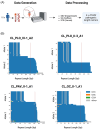Identification of GGC Repeat Expansions in ZFHX3 among Chilean Movement Disorder Patients
- PMID: 40459184
- PMCID: PMC12273613
- DOI: 10.1002/mds.30242
Identification of GGC Repeat Expansions in ZFHX3 among Chilean Movement Disorder Patients
Abstract
Background: Hereditary ataxias are genetically diverse, yet up to 75% remain undiagnosed due to technological and financial barriers. The GGC repeat expansion in ZFHX3, responsible for spinocerebellar ataxia type 4 (SCA4), has only been described in individuals of Northern Europeandescent.
Objective: Uncover the genetic etiology of suspected hereditary movement disorders.
Methods: We performed Oxford Nanopore long-read genome sequencing on 15 individuals with suspected hereditary movement disorders. Using variant calling and ancestry inference tools.
Results: We identified ZFHX3 GGC expansions (47-55 repeats) in 4 patients with progressive ataxia, polyneuropathy, and vermis atrophy. One presented with rapidly progressive parkinsonism-ataxia, expanding the known phenotype. Longer expansions correlated with earlier onset and severity. All carriers shared single nucleotide variants (SNVs) associated with the Swedish founder haplotype, and methylation analysis confirmed allele-specific hypermethylation.
Conclusion: These represent the first SCA4 cases identified outside Northern Europe. Our findings highlight the value of long-read sequencing in resolving undiagnosed movement disorders. Published 2025. This article is a U.S. Government work and is in the public domain in the USA. Movement Disorders published by Wiley Periodicals LLC on behalf of International Parkinson and Movement Disorder Society.
Keywords: Latin American Population; Long Read Sequencing; Spinocerebellar Ataxias; Tandem Repeat Expansions; ZFHX3 gene.
Published 2025. This article is a U.S. Government work and is in the public domain in the USA. Movement Disorders published by Wiley Periodicals LLC on behalf of International Parkinson and Movement Disorder Society.
Figures


Update of
-
Identification of GGC Repeat Expansions in ZFHX3 Among Chilean Movement Disorder Patients.medRxiv [Preprint]. 2025 Mar 19:2025.03.17.25323863. doi: 10.1101/2025.03.17.25323863. medRxiv. 2025. Update in: Mov Disord. 2025 Jul;40(7):1433-1441. doi: 10.1002/mds.30242. PMID: 40166539 Free PMC article. Updated. Preprint.
References
-
- Saffie P, Schuh A, Muñoz D, Fernández J, Canals F, Chaná‐Cuevas P. LBA‐24: Diagnostic yield of Next Generation Sequencing techniques in a movement disorders center in Chile. In International Congress of Parkinson's Disease and Movement Disorders; Available from: https://www.mdscongress.org/Congress-Files/2022-Madrid-Congress_Late-Bre....
-
- Figueroa KP, Gross C, Buena‐Atienza E, Paul S, Gandelman M, Kakar N, et al. A GGC‐repeat expansion in ZFHX3 encoding polyglycine causes spinocerebellar ataxia type 4 and impairs autophagy. Nat Genet 2024;56(6):1080–1089. - PubMed
MeSH terms
Substances
Grants and funding
- Michael J. Fox Foundation for Parkinson's Research
- Z99 AG999999/ImNIH/Intramural NIH HHS/United States
- ZIAAG000538/NH/NIH HHS/United States
- UCLH Biomedical Research Centre
- T32 HG000035/HG/NHGRI NIH HHS/United States
- DP5OD033357/NH/NIH HHS/United States
- ZIANS003154/NH/NIH HHS/United States
- DP5 OD033357/OD/NIH HHS/United States
- AG000538/NH/NIH HHS/United States
- ZIA AG000538/ImNIH/Intramural NIH HHS/United States
- 5T32HG000035-29/NH/NIH HHS/United States
- R01HG011649/NH/NIH HHS/United States
- P01 AG000538/AG/NIA NIH HHS/United States
- R01 HG011649/HG/NHGRI NIH HHS/United States
- ZIA NS003154/ImNIH/Intramural NIH HHS/United States
- National Institute for Health and Care Research
- WT_/Wellcome Trust/United Kingdom
- 5T32HG000035-29/NH/NIH HHS/United States
- AG000538/NH/NIH HHS/United States
- DP5OD033357/NH/NIH HHS/United States
- R01HG011649/NH/NIH HHS/United States
- ZIAAG000538/NH/NIH HHS/United States
- ZIANS003154/NH/NIH HHS/United States
- MRC_/Medical Research Council/United Kingdom
- WT_/Wellcome Trust/United Kingdom
LinkOut - more resources
Full Text Sources
Medical

